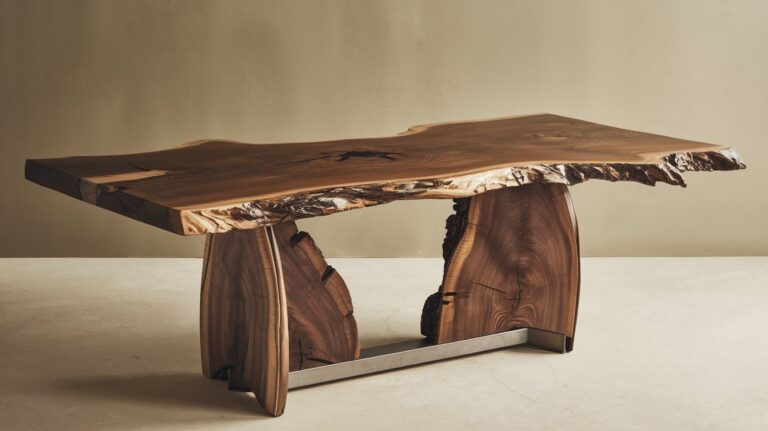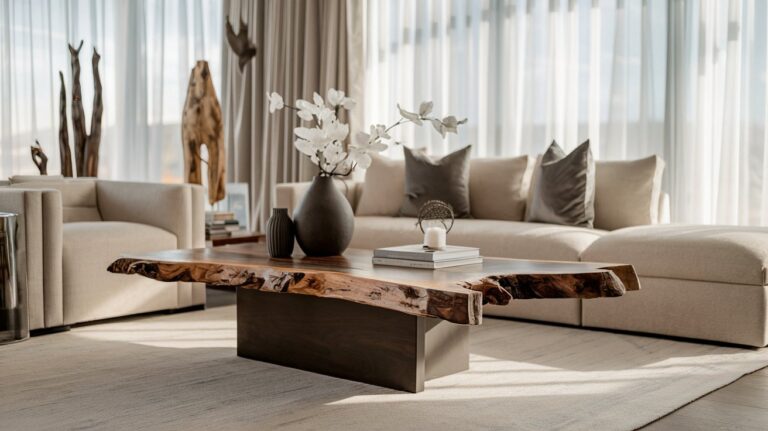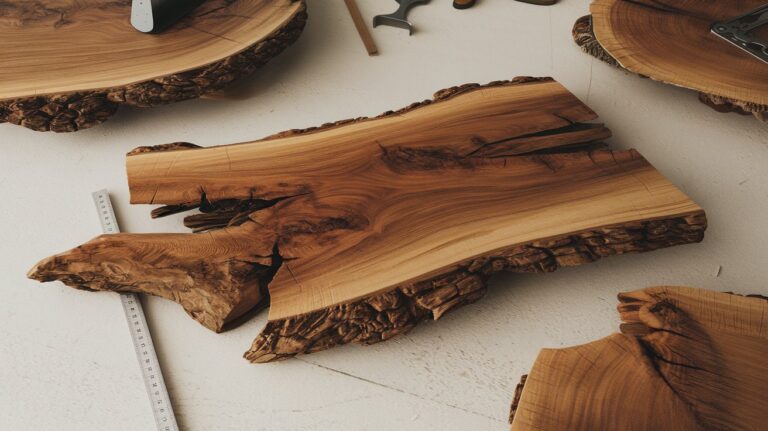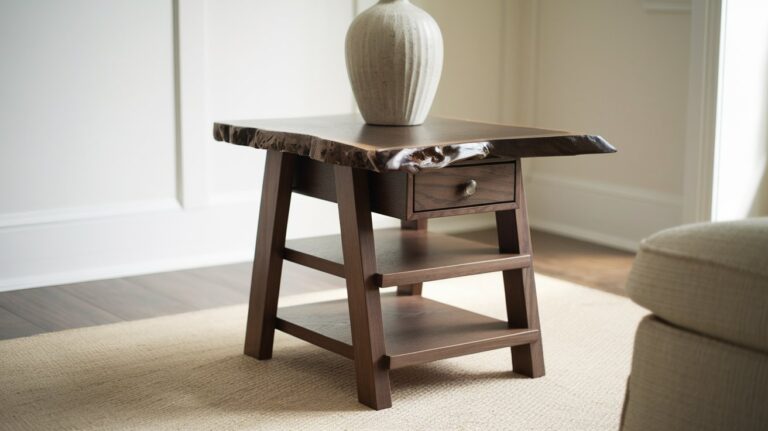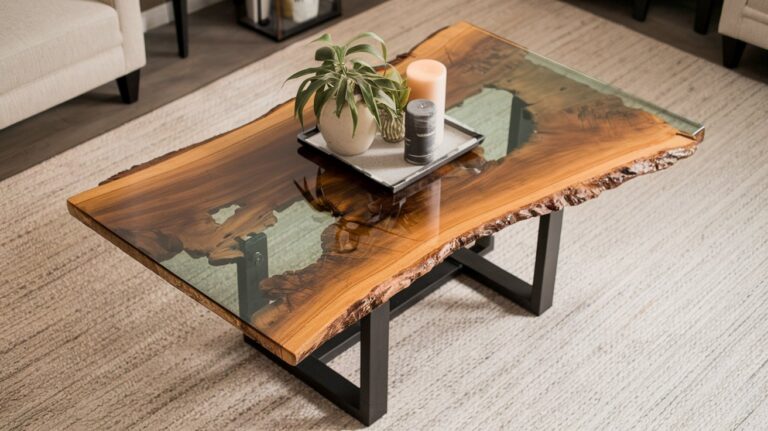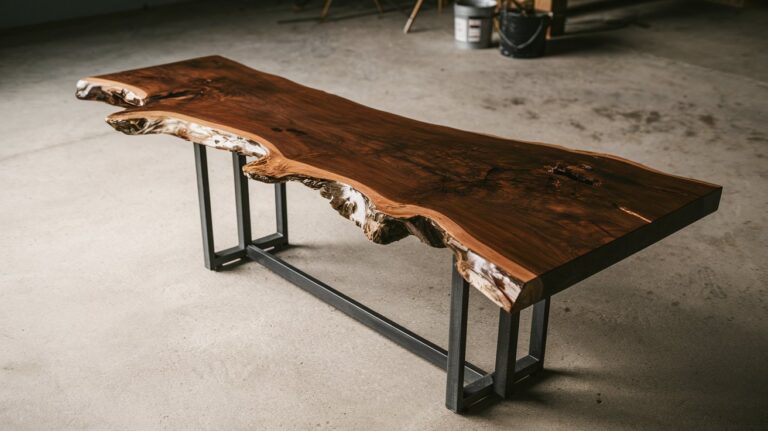Live Edge River Table Guide: Build, Buy & Cost 2025
A live edge river table combines natural wood slabs with epoxy resin to create stunning furniture pieces that showcase nature’s beauty. These handcrafted tables feature the wood’s natural edge on one side while incorporating a flowing epoxy ‘river’ down the center, making each piece unique and highly sought after in 2025.
What Is A Live Edge River Table
A live edge river table is a unique furniture piece that preserves the natural bark edge of wood slabs while incorporating an epoxy resin river flowing through the center. The term ‘live edge’ refers to keeping the wood’s natural, unprocessed edge, while the ‘river’ describes the flowing epoxy resin that fills gaps between wood pieces. These tables typically use hardwood species like walnut, oak, or cherry, with clear or colored epoxy creating dramatic visual effects.
The construction process involves cutting a single wood slab in half, creating space for the epoxy river, then carefully pouring and curing resin to form a smooth, glass-like surface. This technique originated from traditional woodworking but gained massive popularity in the 2020s as homeowners sought unique, nature-inspired furniture pieces that serve as functional art.
Live Edge River Table Cost Breakdown 2025
The live edge river table cost varies significantly based on size, wood species, and craftsmanship quality. In 2025, expect to pay between $800 for smaller coffee tables to $8,000 for large dining tables from professional makers. DIY projects can reduce costs by 40-60%, with material expenses ranging from $200-$1,200 depending on wood choice and epoxy quality.
Professional makers in the United States charge $15-$50 per square foot for live edge river tables, with premium exotic woods commanding higher prices. Custom pieces featuring book-matched slabs or complex epoxy designs can exceed $10,000. The epoxy alone costs $3-$8 per ounce, with larger tables requiring 1-3 gallons of high-quality resin.
Material Costs For DIY Projects
Wood slabs represent the largest expense in DIY live edge river table projects. Domestic hardwoods like oak or maple cost $8-$15 per board foot, while exotic species like walnut or cherry range from $15-$25 per board foot. A typical coffee table requires 15-25 board feet, while dining tables need 40-80 board feet of quality lumber.
Professional vs DIY Cost Comparison
Professional live edge river tables include design consultation, premium materials, expert craftsmanship, and warranties. DIY projects save on labor costs but require specialized tools, workspace, and significant time investment. Professional tables offer guaranteed quality and finished appearance, while DIY projects provide customization control and cost savings of 50-70%.
How To Make A Live Edge River Table Step-By-Step
Building a live edge river table requires careful planning, quality materials, and patience during the multi-day process. The project involves selecting appropriate wood slabs, preparing the workspace, creating templates, routing channels for epoxy, and multiple sanding and finishing stages. Success depends on proper preparation and allowing adequate curing time for epoxy resin.
The complete process typically takes 2-3 weeks, including wood preparation, epoxy curing, and final finishing. Essential tools include a router, sanders, clamps, and safety equipment. Working in a dust-free environment with stable temperature (68-75°F) ensures optimal epoxy resin curing and prevents contamination during the pour.
Wood Selection and Preparation
Choose kiln-dried hardwood slabs with moisture content below 8% for stable live edge river tables. Popular species include black walnut, white oak, and cherry for their grain patterns and durability. Slabs should be 2-3 inches thick for coffee tables and 3-4 inches for dining tables. Inspect for cracks, insect damage, and ensure the live edge is intact without loose bark sections.
Essential Tools and Materials
Essential tools for live edge river table construction include a router with edge guide, orbital sanders (80-220 grit), clamps, and measuring tools. Materials needed are high-quality epoxy resin (2-part system), wood conditioner, polyurethane finish, and safety equipment including respirator masks and nitrile gloves. Budget $150-$300 for basic tool requirements.
Wood Thickness Requirements For River Tables
Proper wood thickness is crucial for live edge river table stability and longevity. Coffee tables require minimum 1.5-2 inches thickness, while dining tables need 2.5-3 inches to support daily use without warping or cracking. Thicker slabs provide better structural integrity and allow for deeper routing channels that accommodate substantial epoxy rivers.
The thick wood requirement also depends on table span and leg placement. Tables over 6 feet long need increased thickness to prevent sagging, with 3-4 inch slabs recommended for spans exceeding 8 feet. Additional thickness provides more sanding allowance during finishing and creates more dramatic visual impact with deeper epoxy channels.
Are Live Edge Tables Hard To Make
Live edge tables present moderate difficulty for experienced woodworkers but challenge beginners due to specialized techniques and material costs. The process requires precision routing, understanding epoxy chemistry, and patience during multi-stage construction. Success rates improve significantly with proper preparation, quality materials, and following proven techniques rather than rushing the process.
Common challenges include achieving level surfaces, preventing epoxy leaks, managing bubble formation, and matching wood grain patterns. The hard to make aspect stems from epoxy’s unforgiving nature – mistakes are difficult to correct once resin cures. However, with careful planning and attention to detail, motivated DIY enthusiasts successfully complete beautiful river tables.
Skill Level Requirements
Intermediate woodworking skills are recommended for live edge river table projects. Essential abilities include accurate measuring, router operation, surface preparation, and finishing techniques. Beginners should practice epoxy techniques on small projects before attempting full tables. Understanding wood movement and grain direction prevents costly mistakes during construction.
Common Mistakes To Avoid
Frequent errors in live edge river table construction include inadequate sealing leading to epoxy leaks, rushing cure times causing weak bonds, and improper mixing ratios creating soft or cloudy epoxy. Temperature control during pours prevents bubble formation and ensures proper curing. Using low-quality epoxy results in yellowing and reduced durability over time.
Best Places To Buy Live Edge River Tables
The market for live edge river tables for sale has expanded significantly in 2025, with options ranging from local artisan workshops to online marketplaces. Etsy features over 5,000 custom makers offering personalized designs, while furniture stores increasingly stock ready-made pieces. Custom furniture makers provide the highest quality but require 6-12 week lead times and premium pricing.
Online platforms like CustomMade.com connect buyers with verified craftspeople, while local woodworking shops offer opportunities to see pieces in person before purchasing. Facebook Marketplace and Craigslist feature both new and used live edge river tables, though buyers should inspect quality carefully and verify maker credentials before purchasing expensive pieces.
Epoxy River Table Kits and Plans
Epoxy resin table kits simplify the building process by including pre-measured materials, detailed instructions, and sometimes pre-cut wood slabs. Major suppliers like EpoxyPlus and TotalBoat offer comprehensive kits ranging from $150-$800, depending on table size and included components. These kits reduce guesswork and ensure compatible materials for successful projects.
Digital live edge river table plans provide detailed blueprints, cutting lists, and step-by-step instructions for various skill levels. Popular plan sources include Ana White, Steve Ramsey’s Weekend Woodworker, and specialized epoxy furniture designers. Plans typically cost $15-$50 and include multiple size variations and design options for customization.
Kit Components and Value
Quality epoxy resin table kits include measured resin and hardener, mixing cups, stirring sticks, and detailed instructions. Premium kits add pigments, metallic powders, and safety equipment. Compare kit prices against individual component costs – quality kits typically save 15-25% versus buying materials separately while ensuring component compatibility.
Choosing The Right Plans
Select live edge river table plans matching your skill level and available tools. Beginner plans focus on simple rectangular designs, while advanced plans include curved edges and complex joinery. Look for plans including material lists, tool requirements, and troubleshooting sections. Video-accompanied plans provide visual guidance for complex steps like epoxy pouring techniques.
Related video about live edge river table
This video complements the article information with a practical visual demonstration.
Frequently Asked Questions
How much does a live edge river table cost in 2025?
Live edge river table prices in 2025 range from $800-$8,000 depending on size, wood species, and craftsmanship. Coffee tables typically cost $800-$2,500, while dining tables range $2,000-$8,000. DIY projects cost $200-$1,200 in materials, saving 50-70% compared to professional pieces.
What wood thickness is needed for a river table?
Coffee tables require 1.5-2 inch thick wood slabs minimum, while dining tables need 2.5-3 inches for proper stability. Tables over 6 feet long should use 3-4 inch thick slabs to prevent sagging. Thicker wood provides better structural integrity and allows deeper epoxy channels.
Are live edge river tables difficult to make?
Live edge river tables present moderate difficulty requiring intermediate woodworking skills. Main challenges include precision routing, epoxy handling, and patience during multi-stage construction. Success depends on proper preparation, quality materials, and allowing adequate curing time rather than rushing the process.
Where can I buy live edge river tables?
Live edge river tables are available through custom furniture makers, Etsy artisans, online platforms like CustomMade.com, and increasingly in furniture stores. Local woodworking shops offer viewing opportunities, while Facebook Marketplace and Craigslist feature both new and used options at various price points.
How long does it take to make a live edge river table?
Building a live edge river table typically takes 2-3 weeks including wood preparation, epoxy curing, and final finishing. Active work time ranges 20-40 hours depending on size and complexity, but epoxy curing requires 48-72 hours between major steps, extending total project timeline.
| Project Aspect | Key Requirements | Expected Outcome |
|---|---|---|
| Wood Selection | 2-3 inch kiln-dried hardwood, under 8% moisture | Stable, warp-resistant foundation |
| Epoxy Quality | High-grade 2-part resin, proper mixing ratios | Crystal-clear, durable river finish |
| Time Investment | 20-40 hours work, 2-3 weeks total time | Professional-quality finished table |
| Cost Range | $200-$1,200 DIY, $800-$8,000 professional | Significant savings with DIY approach |

